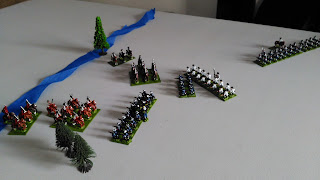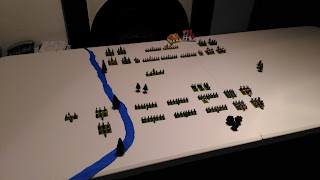A DAY late, but we are under way.
Here's my plan.
Clearly the Austrians cannot win a pure musketry duel, and I must make full use of my overwhelming advantage in cavalry.
In order to bring about a horse-v-horse confrontation with as little interference as possible from the Prussian foot, I intend copying a manoeuvre used in 1741 - namely sending my left-flank cavalry on a wide arc in order to attack their Prussian opposite numbers from the side.
My right-flank horse will be sent across the Kleinerbach to take on the Prussian horse there.
My infantry will await the onslaught of the Prussian foot. At least my guns should be able to rake the bluecoats with canister when they close to musketry range.
The figure of von Neipperg will be moved to join the hussars.
TURN ONE
Frederick's only moves were to continue getting his right flank into order. He has apparently decided not to advance until everything is ready.
(Something similar happened in 1741. The Austrians were not aware of Frederick's approach, and the Prussians could have attacked them in camp. But the King, uncharacteristically cautious in his first battle, stopped to get all his troops lined up in regular formations.)
I sent my cavalry off on their respective roles - the left wing to outflank the Prussian right, and the right-wing to cross the Kleinerbach.
 |
| Looking from behind the Prussian right. In the background the Austrian left-flank horse can be seen swinging to their left |
The Prussian artillery, just within range of my infantry, opened fire, scoring a hit on the Deutschmeister Foot, who passed the subsequent morale test.
My guns, not being sited forward of the first line, were out-of-range of the Prussian foot. One gun was able to fire at the Prussian guns, but this counter-battery fire was completely ineffective.
TURN TWO
I ordered my infantry lines to fall back out of range of the Prussian guns, causing Frederick to order his guns to limber (this is shown by pointing the guns away from the enemy).
The only firing was by my left-flank gun, which scored a hit on one of the Prussian guns.
Frederick intriguingly sent his hussars obliquely forward, much to my puzzlement as I was not sure what he hoped to achieve by this.
 |
| The Austrian right-flank cavalry cross the Kleinerbach. Directly to their front is the half-squadron of Frederick's King's Hussars |
TURN THREE
Frederick ordered his left-flank heavy horse forward, apparently trying to take advantage of the somewhat disjointed state of the Austrian horse crossing the stream.
 |
| Frederick's left-flank cuirassiers and dragoons advance |
In the centre, I ordered my infantry to fall back some more.
The Prussians began a general advance, which brought their first line within roundshot range of my guns, the von Lehwaldt Foot suffering a hit.
 |
| Looking from behind the Prussian centre. The boulder next to the right-hand gun indicates it has suffered a hit |
 |
| The view from behind the Prussian right |
TURN FOUR
Frederick's guns, now within range of my infantry again, unlimbered. Meanwhile, my own guns failed to inflict any casualties on the Prussian foot.
On both flanks there was a clash of cuirassiers, with the Prussians losing the melee in each case. The von Buddenbrock Cuirassiers were particularly badly affected, losing 50 percent of their effectiveness.
 |
| Looking from the rooftops of Mollwitz village towards the advancing Prussian centre |
TURN FIVE
On the Prussian left, the retreating Brandenburg-Schwedt Cuirassiers were caught from behind by my Hohen-Ems Cuirassiers. On the Prussian right, something similar happened as the fleeing Buddenbrock Cuirassiers were charged in the rear by a squadron of my already victorious Modena Cuirassiers.
This was rather careless by Frederick as, under our alternate-moving rules, he had time to get at least one unit out of harm's way.
In a development echoing what happened in the real battle, the two extreme-right battalions of Prussian foot turned to try to deal with the Austrian horse (a sign of General Field Marshal von Schwerin acting on his own initiative, perhaps?),
 |
| On the Prussian right, two battalions turn to face the Austrian horse sweeping by |
 |
| A view of the general cavalry melee on the Prussian left |
We calculated artillery firing before the melees, and with dramatic results.
The Prussian Lehwaldt Foot were reduced to 50 percent effectiveness, but managed to pass their morale test. Alas, the same could not be said for my Deutschmeister Foot who, taking their second hit of the battle, found their bravery deserting them and they promptly took to their heels.
 |
| Looking from behind the Prussian guns. In the far background the surviving members of the Deutschmeister Foot can just be seen fleeing between the hussars and Mollwitz village |
The melees were something of a disaster for Frederick with both his cuirassier squadrons wiped out. The Brandenburg-Schwedt Cuirassiers did as least inflict two hits on their attackers, only to see both hits cancelled by my producing a pair of 6s with my saving throws (cuirassiers have a saving throw from hits of a 6, thanks to their cuirass).
One small bright note for the Prussians was that the Porzellan Dragoons held their own against my Cordova Cuirassiers, each squadron inflicting a hit.
Units eliminated at the end of turn five: two squadrons of Prussian heavy cavalry.
TURN SIX
I moved the figure of von Neipperg to intercept the retreating Deutschmeister Foot, and he successfully rallied them.
My infantry hastily rearranged themselves to plug the hole in the first line, although the Karl von Lothringen Foot, in their eagerness, pushed further forward than their comrades (the move-variation rule coming into effect).
Both my guns fired canister, inflicting a hit on the Prussian right-flank von Leps Foot and the left-flank Brandenburg-Schwedt Foot. The von Leps passed their morale test but the Brandenburg-Schwedt, perhaps shaken by the fate of the Brandenburg-Schwedt Cuirassiers, broke and fled.
The Prussian guns had even more success, concentrating their fire on the Rios-Deutschmeister Grenadiers which, thanks to failing their morale test, ceased to exist as a unit.
On the Prussian left, the Porzelan Dragoons, suffered a second round of meleeing against the Cordova Cuirassiers and were also hit in the flank by the Hohen-Ems Cuirassiers. Not surprisingly, the dragoons were wiped out, but not before reducing the Cordova squadron to 25 percent effectiveness.
On the Prussian right, a squadron of my Modena Cuirassiers clashed bloodily with the von Bayreuth Dragoons. Each inflicted three hits, meaning there would be a second round of meleeing. Also on this flank, my other squadron of Modena Cuirassiers suffered a musketry hit from the battalion of von Glasenapp Foot that had turned to help out their cavalry. The cuirassiers failed the subsequent morale test, losing a further 25 percent effectiveness.
 |
| An aerial view showing the Prussian centre pushing forward while the Austrian horse are victorious on both flanks |
Units eliminated at the end of turn six: three squadrons of Prussian heavy cavalry; one battalion of Austrian foot.
TURN SEVEN
A combination of musketry and canister disposed of the remaining von Leps Foot, although not before they had scored a hit on my left-flank gunners, whose morale nevertheless remained steadfast.
The Prussian left-flank von Glasenapp Foot also suffered a hit from canister, but passed their morale test.
Further to the left, beyond the Kleinerbach, the ponderous nature of the Prussian horse was highlighted when my Batthyány Dragoons caught the King's Hussars in the flank and destroyed them without suffering any losses.
On the other flank, the dragoon-cuirassier melee was again drawn.
 |
| Massed Austrian horse prepare to ford the Kleinerbach for an easy-looking prey in the shape of the retreating Brandenburg-Schwedt Foot |
Units eliminated at the end of turn seven: three squadrons of Prussian heavy cavalry, the half-squadron of Prussian hussars and one battalion each of Prussian and Austrian foot.
TURN EIGHT
Another bloodthirsty round.
The Brandenburg-Schwedt Foot met their inevitable fate, at the hands of the Prinz Savoyen Dragoons.
It was also a successful round for the Prussian von Bayreuth Dragoons, who finally got the upper hand and eliminated a squadron of my Modena Cuirassiers.
 |
| Despite horrendous losses, the Prussian foot, with King Frederick in their midst, continue to close in on the Austrian troops in front of Mollwitz |
Units eliminated at the end of turn eight: three squadrons of Prussian heavy cavalry, the half-squadron of Prussian hussars, two battalions of Prussian foot; one squadron of Austrian heavy cavalry, one battalion of Austrian foot.
To be continued






















